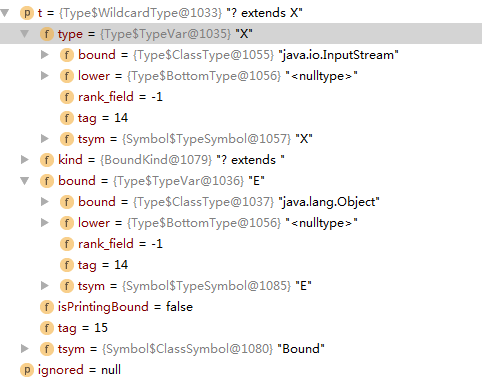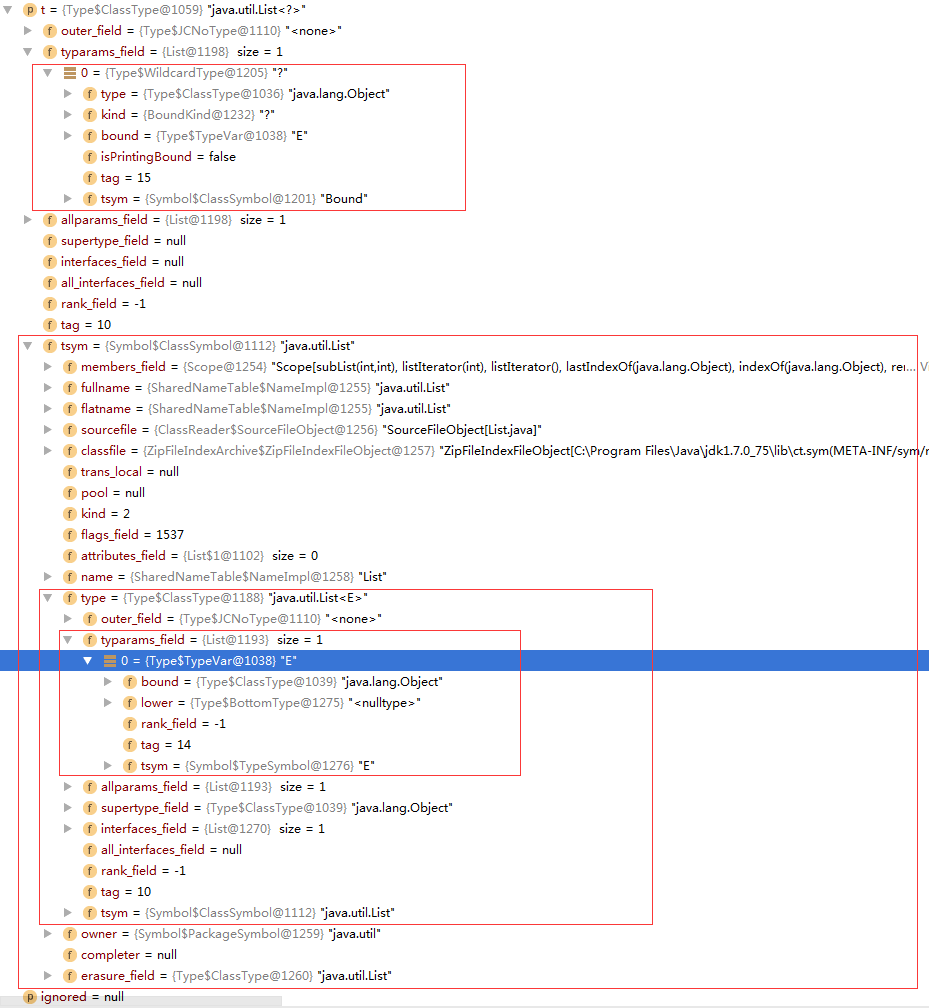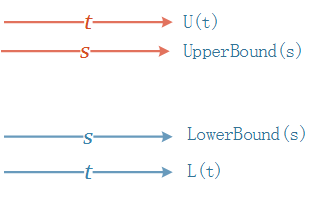Types方法之upperBound-lowerBound-isUnbounded-containsType
1、upperBound(Type t)方法
/**
* The "rvalue conversion".
* The upper bound of most types is the type itself. Wildcards, on the other hand have upper and lower bounds.
* @param t a type
* @return the upper bound of the given type
*/
public Type upperBound(Type t) {
return upperBound.visit(t);
}
// where
private final MapVisitor<Void> upperBound = new MapVisitor<Void>() {
@Override
public Type visitWildcardType(WildcardType t, Void ignored) {
if (t.isSuperBound())
return t.bound == null ? syms.objectType : t.bound.bound;
else
return visit(t.type);
}
@Override
public Type visitCapturedType(CapturedType t, Void ignored) {
return visit(t.bound);
}
};
举个例子,如List<?>或者List<? super InputStream>时,这个WildcardType的isSuperBound()返回都为true,如果为List<?>,那么上界为Object类型,否则就是类声明的上界。查看List的实现,如下:
public interface List<E> extends Collection<E> {
// ...
}
那么bound类型为E,bound.bound为Object。如果为List<? super X>时,如下:
public class Test<X> {
public void test() {
List<? super X> x;
}
}
那么bound类型为TypeVar,则TypeVar的bound为X的bound
如果为List<? extends InputStream>或List<? extends X>时会调用visit(t.type),而这个type类型就是InputStream(ClassType类型)或者X(TypeVar类型)来继续查找上界。举个例子如下:
public class Test<X extends InputStream> {
public void test(){
List<? extends X> x = new ArrayList();
x.add(null);
}
}
这时候传入方法的t参数如下:

调用visit(t.type)后会返回TypeVar类型,如果为CapturedType,那么就访问upperBound实例中的visitCapturedType(CapturedType t,Void ignored)方法,然后继续visit(t.bound)进行上界的查找。
2、lowerBound(Type t)方法
/**
* The "lvalue conversion".
* The lower bound of most types is the type itself. Wildcards, on the other hand have upper and lower bounds.
* @param t a type
* @return the lower bound of the given type
*/
public Type lowerBound(Type t) {
return lowerBound.visit(t);
}
// where
private final MapVisitor<Void> lowerBound = new MapVisitor<Void>() {
@Override
public Type visitWildcardType(WildcardType t, Void ignored) {
return t.isExtendsBound() ? syms.botType : visit(t.type);
}
@Override
public Type visitCapturedType(CapturedType t, Void ignored) {
return visit(t.getLowerBound());
}
};
如果如List<?>或者List<? extends InputStream>或者List<? extends T>时,下界为null,否则就是List<? super InputStream>或者List<? super T>时调用visit(t.type)查找下界,如果t.type为非CapturedType,那么下界就是t.type,如果为CapturedType类型时,则继续查找
t.getLowerBound()类型的下界。
3、isUnbounded(Type t)方法
/**
* Checks that all the arguments to a class are unbounded wildcards or something else that doesn't make any restrictions
* on the arguments. If a class isUnbounded, a raw super- or subclass can be cast to it without a warning.
* @param t a type
* @return true iff the given type is unbounded or raw
*/
public boolean isUnbounded(Type t) {
return isUnbounded.visit(t);
}
// where
private final UnaryVisitor<Boolean> isUnbounded = new UnaryVisitor<Boolean>() {
public Boolean visitType(Type t, Void ignored) {
return true;
}
@Override
public Boolean visitClassType(ClassType t, Void ignored) {
List<Type> parms = t.tsym.type.allparams();
List<Type> args = t.allparams();
while (parms.nonEmpty()) {
// public WildcardType(Type type, BoundKind kind, TypeSymbol tsym, TypeVar bound)
WildcardType unb = new WildcardType(syms.objectType,
BoundKind.UNBOUND,
syms.boundClass,
(TypeVar)parms.head);
if (!containsType(args.head, unb)) {
return false;
}
parms = parms.tail;
args = args.tail;
}
return true;
}
};
举个例子,如下:
List<? extends X> x = new ArrayList(); Object y = (List<?>)x;
传入的ClassType的t参数如下截图:

实际的类型参数是否包含形式类型参数来决定是否对实际的类型参数产生约束。
3、containsType() 方法
这个方法的注释如下:
Check if t contains s.
T contains S if:
L(T) <: L(S) && U(S) <: U(T)
This relation is only used by ClassType.isSubtype(), that is,
C<S> <: C<T> if T contains S.
Because of F-bounds, this relation can lead to infinite recursion. Thus we must somehow break that recursion. Notice that containsType() is only called from ClassType.isSubtype(). Since the arguments have already been checked against their bounds, we know:
U(S) <: U(T) if T is "super" bound (U(T) *is* the bound)
L(T) <: L(S) if T is "extends" bound (L(T) is bottom)
通过如下方法就可知道代码是如何来判断两者之间的关系的,如下:
void debugContainsType(WildcardType t, Type s) {
System.err.println();
System.err.format(" does %s contain %s?%n", t, s);
System.err.format(" %s U(%s) <: U(%s) %s = %s%n",
upperBound(s), s, t, U(t),
t.isSuperBound() ||
isSubtypeNoCapture(upperBound(s), U(t)));
System.err.format(" %s L(%s) <: L(%s) %s = %s%n",
L(t), t, s, lowerBound(s),
t.isExtendsBound() ||
isSubtypeNoCapture(L(t), lowerBound(s)));
System.err.println();
}
在TypeRelation匿名类中,有两个私有方法,代码如下:
private Type U(Type t) {
while (t.tag == WILDCARD) {
WildcardType w = (WildcardType)t;
if (w.isSuperBound())
return w.bound == null ? syms.objectType : w.bound.bound;
else
t = w.type;
}
return t;
}
private Type L(Type t) {
while (t.tag == WILDCARD) {
WildcardType w = (WildcardType)t;
if (w.isExtendsBound())
return syms.botType;
else
t = w.type;
}
return t;
}
主要的逻辑就是求通配符的上界和下界。剩下就是处理特定几个类型了,如下:
@Override
public Boolean visitWildcardType(WildcardType t, Type s) {
if (s.tag >= firstPartialTag)
return containedBy(s, t);
else {
debugContainsType(t, s);
if(isSameWildcard(t, s)){
return true;
}
if(isCaptureOf(s, t)){
return true;
}
boolean a = t.isExtendsBound() || isSubtypeNoCapture(L(t), lowerBound(s));
boolean b = t.isSuperBound() || isSubtypeNoCapture(upperBound(s), U(t));
return a && b;
}
}
可以看到主要还是处理WildcardType与UndeterminedVariable类型。
(1)visitWildcardType(WildcardType t,Type s)判断t是否包含了s类型,如果s.tag>=firstPartialTag,那么调用containedBy(s,t)方法来判断两者之间的关系。也就是
/** The tag of an unknown type
*/
public static final int UNKNOWN = ERROR+1;
/** The tag of all instantiatable type variables.
*/
public static final int UNDETVAR = UNKNOWN+1;
/** The number of type tags.
*/
public static final int TypeTagCount = UNDETVAR+1;
当s为UNKNOWN或者UNDETVAR类型时调用containedBy()方法。
当s与t是两个相同的WildcardType时,返回true,如何判断两个WildcardType类型相同呢?
public boolean isSameWildcard(WildcardType t, Type s) {
if (s.tag != WILDCARD)
return false;
WildcardType w = (WildcardType)s;
return w.kind == t.kind && w.type == t.type;
}
kind相同同时type也相同,kind是一个枚举类型,如下:
public enum BoundKind {
EXTENDS("? extends "),
SUPER("? super "),
UNBOUND("?");
private final String name;
BoundKind(String name) {
this.name = name;
}
public String toString() { return name; }
}
接下来调用isCaptureOf()方法进行判断,代码如下:
public boolean isCaptureOf(Type s, WildcardType t) {
if (s.tag != TYPEVAR || !((TypeVar)s).isCaptured())
return false;
return isSameWildcard(t, ((CapturedType)s).wildcard);
}
看一下CaptureType类型的实现代码,如下:
/** A captured type variable comes from wildcards which can have
* both upper and lower bound. CapturedType extends TypeVar with a lower bound.
*/
public static class CapturedType extends TypeVar {
public WildcardType wildcard;
public CapturedType(Name name,
Symbol owner,
Type upper,
Type lower,
WildcardType wildcard) {
super(name, owner, lower);
this.lower = Assert.checkNonNull(lower);
this.bound = upper;
this.wildcard = wildcard;
}
@Override
public <R,S> R accept(Type.Visitor<R,S> v, S s) {
return v.visitCapturedType(this, s);
}
@Override
public boolean isCaptured() {
return true;
}
@Override
public String toString() {
return "capture#"
+ (hashCode() & 0xFFFFFFFFL) % Printer.PRIME
+ " of "
+ wildcard;
}
}
这个CaptureType继承了TypeVar类型,也就和TypeVar有相同的tag值。所以如果s.tag!=TYPEVAR,那就一定不是CaptureType类型。然后继续调用TypeVar类型的isCaptured()方法进行了判断。只有CapturedType类型的isCaptured()方法返回true,TypeVar及其它类型返回为false。
也就可以断定,如果走到了if判断语句的下面,那么s类型肯定为CaputuredType。
接下来有两个判断,如下:
boolean a = t.isExtendsBound() || isSubtypeNoCapture(L(t), lowerBound(s)); // L(t)是否为LowerBound(s)的子类型 boolean b = t.isSuperBound() || isSubtypeNoCapture(upperBound(s), U(t)); // upperBound(s)是否为U(t)的子类型
关于isExtendsBond()与isSuperBound()方法定义在WildcardType类型中,代码如下:
public boolean isSuperBound() {
return kind == SUPER || kind == UNBOUND;
}
public boolean isExtendsBound() {
return kind == EXTENDS || kind == UNBOUND;
}
public boolean isUnbound() {
return kind == UNBOUND;
}
关于a与b的判断条件如下:

当t要包含s类型时,t的上界要大于s的上界,t的下界要小于s的下界。
当t为UndetVar类型时,判断逻辑代码如下:
@Override
public Boolean visitUndetVar(UndetVar t, Type s) {
if (s.tag != WILDCARD)
return isSameType(t, s);
else
return false;
}
当s不为通配符类型时判断是否为同一个类型,否则就没有包含的关系。
@Override
public Boolean visitType(Type t, Type s) {
if (s.tag >= firstPartialTag)
return containedBy(s, t);
else
return isSameType(t, s);
}
@Override
public Boolean visitErrorType(ErrorType t, Type s) {
return true;
}
也就是如果t是非ErrorType,CapturedType与UndetVar类型时,会调用visitType()方法来判断包含关系。
当t为ErrorType时为什么会返回true?
Types方法之upperBound-lowerBound-isUnbounded-containsType的更多相关文章
- Types方法之isSameType-isSuperType-isSubType
4.isSameType() 方法 /** * Is t the same type as s? */ public boolean isSameType(Type t, Type s) { retu ...
- Types方法之isCastable-isConvertible
5. Conversions and Promotions 5.1. Kinds of Conversion 5.1.1. Identity Conversion 5.1.2. Widening Pr ...
- java.lang.OutOfMemoryError: bitmap size exceeds VM budget解决方法
1 BitmapFactory.decodeFile(imageFile); 用BitmapFactory解码一张图片时,有时会遇到该错误.这往往是由于图片过大造成的.要想正常使用,则需要分配更少的内 ...
- runtime第三部分方法和消息
接上一篇http://www.cnblogs.com/ddavidXu/p/5924049.html 转载来源http://www.jianshu.com/p/6b905584f536 http:// ...
- Runtime 动态加载方法
动态加载 #import"ViewController.h" #import"Person.h" @interfaceViewController() @end ...
- Objective-C Runtime 运行时之三:方法与消息
基础数据类型 SEL SEL又叫选择器,是表示一个方法的selector的指针,其定义如下: typedef struct objc_selector *SEL; objc_selector结构体的详 ...
- Objective-C Runtime 运行时之三:方法与消息(转载)
前面我们讨论了Runtime中对类和对象的处理,及对成员变量与属性的处理.这一章,我们就要开始讨论Runtime中最有意思的一部分:消息处理机制.我们将详细讨论消息的发送及消息的转发.不过在讨论消息之 ...
- iOS运行时使用(动态添加方法)
1 举例 我们实现一个Person类 然后Person 其实是没得对象方法eat:的 下面调用person的eat方法 程序是会奔溃的 那么需要借助运行时动态的添加方法 Person *p = [[ ...
- BitmapFactory.Options.inSampleSize 的使用方法
BitmapFactory.decodeFile(imageFile); 用BitmapFactory解码一张图片时.有时会遇到该错误. 这往往是因为图片过大造成的. 要想正常使用,则须要分配更少的内 ...
随机推荐
- Git在windows环境下的使用教程
前言 安装 配置 关于git使用的几个问题 后记 关于代码托管,以前用过vss和svn,看博客或论坛的时候,经常有人提到github,有很多著名的开源软件都托管在github,想来肯定不错(莫笑),当 ...
- STL中的algorithm
STL中的algorithm #include<algorithm>中的泛函算法,需要添加头文件. 搜索算法:find() .search() .count() .find_if() .s ...
- [转] ubuntu安装Sublime Text 3并使用SublimeClang插件
原文地址:https://blog.csdn.net/cywosp/article/details/32721011 3. 安装强大的SublimeClang插件 SublimeClang是Subli ...
- hdu 2063 匈牙利算法
http://acm.hdu.edu.cn/showproblem.php?pid=2063 男女配对最大数 匈牙利算法模板 #include <cstdio> #include < ...
- Android-Git命令行操作
Git命令行操作,在Mac上使用的话,Mac会自带了Git,直接在终端或者iTerm都可以执行Git命令操作: Git命令行操作,在Windows系统电脑上使用的话,需要安装Git,安装好Git ...
- 将Heap RID转换成RID格式
使用DBCC PAGE命令查看索引叶子层中的索引键(最后一个参数为3才会显示索引键对应的HEAP RID)时,可以使用下面的SQL将HEAP RID转换成 FileId:PageId:SlotNo的格 ...
- Source Multiplayer Networking【转】
https://developer.valvesoftware.com/wiki/Source_Multiplayer_Networking Multiplayer games based on th ...
- ClsoSee(v2) Alpha测试中!这是一个临时的帮助页面...
Clso See 测试中,最新的更新信息会显示在这里,欢迎您随时关注新版本动态. 您可以单击这里让程序打开本地帮助文件(新说明.txt) 等程序完成后,会制作专门的帮助页面. 因为采用了键盘Hook技 ...
- dorado-TabControl
1.TabControl控件有点类似于.net中TableControl控件 2.常用属性 2.1 currentTab页面加载时,默认打开第几个tab,从0开始 2.2 shouMenuButton ...
- C# InDepth 第一章
深入理解C#第一部分,第一章介绍了C#开发得进化史. 1 从数据类型定义引入c#1到4中得改变 c#2:强类型集合(泛型) c#3:自动实现得属性和简化得初始化 c#4:命名实参 2 排序和过滤 排序 ...
